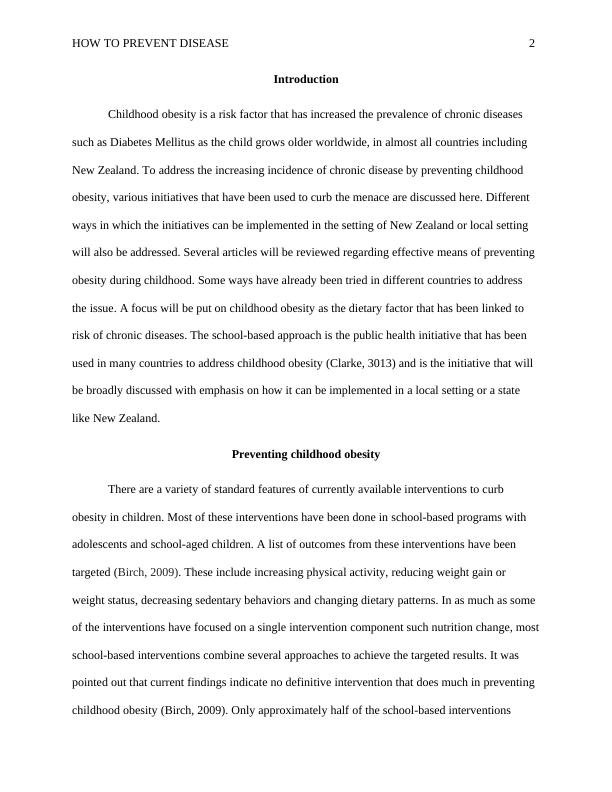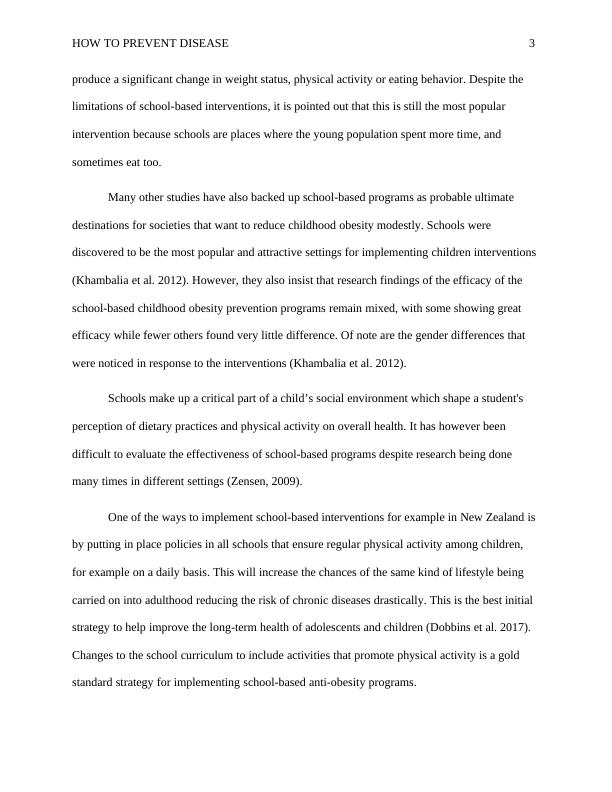Assignment on Childhood Obesity
Added on 2021-05-31
7 Pages1492 Words148 Views
Running head: HOW TO PREVENT DISEASE1Childhood Obesity NameInstitutional Affiliation

HOW TO PREVENT DISEASE2IntroductionChildhood obesity is a risk factor that has increased the prevalence of chronic diseases such as Diabetes Mellitus as the child grows older worldwide, in almost all countries including New Zealand. To address the increasing incidence of chronic disease by preventing childhood obesity, various initiatives that have been used to curb the menace are discussed here. Different ways in which the initiatives can be implemented in the setting of New Zealand or local setting will also be addressed. Several articles will be reviewed regarding effective means of preventing obesity during childhood. Some ways have already been tried in different countries to address the issue. A focus will be put on childhood obesity as the dietary factor that has been linked to risk of chronic diseases. The school-based approach is the public health initiative that has been used in many countries to address childhood obesity (Clarke, 3013) and is the initiative that will be broadly discussed with emphasis on how it can be implemented in a local setting or a state like New Zealand.Preventing childhood obesityThere are a variety of standard features of currently available interventions to curb obesity in children. Most of these interventions have been done in school-based programs with adolescents and school-aged children. A list of outcomes from these interventions have been targeted (Birch, 2009). These include increasing physical activity, reducing weight gain or weight status, decreasing sedentary behaviors and changing dietary patterns. In as much as some of the interventions have focused on a single intervention component such nutrition change, mostschool-based interventions combine several approaches to achieve the targeted results. It was pointed out that current findings indicate no definitive intervention that does much in preventing childhood obesity (Birch, 2009). Only approximately half of the school-based interventions

HOW TO PREVENT DISEASE3produce a significant change in weight status, physical activity or eating behavior. Despite the limitations of school-based interventions, it is pointed out that this is still the most popular intervention because schools are places where the young population spent more time, and sometimes eat too. Many other studies have also backed up school-based programs as probable ultimate destinations for societies that want to reduce childhood obesity modestly. Schools were discovered to be the most popular and attractive settings for implementing children interventions (Khambalia et al. 2012). However, they also insist that research findings of the efficacy of the school-based childhood obesity prevention programs remain mixed, with some showing great efficacy while fewer others found very little difference. Of note are the gender differences that were noticed in response to the interventions (Khambalia et al. 2012). Schools make up a critical part of a child’s social environment which shape a student's perception of dietary practices and physical activity on overall health. It has however been difficult to evaluate the effectiveness of school-based programs despite research being done many times in different settings (Zensen, 2009). One of the ways to implement school-based interventions for example in New Zealand is by putting in place policies in all schools that ensure regular physical activity among children, for example on a daily basis. This will increase the chances of the same kind of lifestyle being carried on into adulthood reducing the risk of chronic diseases drastically. This is the best initial strategy to help improve the long-term health of adolescents and children (Dobbins et al. 2017). Changes to the school curriculum to include activities that promote physical activity is a gold standard strategy for implementing school-based anti-obesity programs.

End of preview
Want to access all the pages? Upload your documents or become a member.
Related Documents
Childhood obesity - Assignment PDFlg...
|13
|3628
|39
Promoting Nutrition in Schools: Evidence-Based Strategies and Program Planlg...
|12
|3016
|256
Health Promotion: Munch and Move Intervention Among Childrenlg...
|17
|4498
|411
Population of Queenslandlg...
|2
|1190
|14
The nutrition program and proposal childhoodlg...
|10
|2400
|55
Childhood Obesity: Causes, Consequences and Prevention Strategieslg...
|6
|1570
|206
